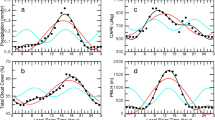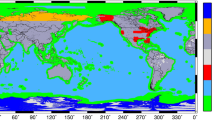Abstract
The recent improvements in the Gravity Recovery And Climate Experiment (GRACE) tracking data processing at GeoForschungsZentrum Potsdam (GFZ) and Groupe de Recherche de Géodésie Spatiale (GRGS) Toulouse, the availability of newer surface gravity data sets in the Arctic, Antarctica and North-America, and the availability of a new mean sea surface height model from altimetry processing at GFZ gave rise to the generation of two new global gravity field models. The first, EIGEN-GL04S1, a satellite-only model complete to degree and order 150 in terms of spherical harmonics, was derived by combination of the latest GFZ Potsdam GRACE-only (EIGEN-GRACE04S) and GRGS Toulouse GRACE/LAGEOS (EIGEN-GL04S) mean field solutions. The second, EIGEN-GL04S1 was combined with surface gravity data from altimetry over the oceans and gravimetry over the continents to derive a new high-resolution global gravity field model called EIGEN-GL04C. This model is complete to degree and order 360 and thus resolves geoid and gravity anomalies at half- wavelengths of 55 km at the equator. A degree-dependent combination method has been applied in order to preserve the high accuracy from the GRACE satellite data in the lower frequency band of the geopotential and to form a smooth transition to the high-frequency information coming from the surface data. Compared to pre-CHAMP global high-resolution models, the accuracy was improved at a spatial resolution of 200 km (half-wavelength) by one order of magnitude to 3 cm in terms of geoid heights. The accuracy of this model (i.e. the commission error) at its full spatial resolution is estimated to be 15 cm. The model shows a reduced artificial meridional striping and an increased correlation of EIGEN-GL04C-derived geostrophic meridional currents with World Ocean Atlas 2001 (WOA01) data. These improvements have led to select EIGEN-GL04C for JASON-1 satellite altimeter data reprocessing.
Similar content being viewed by others
References
Bell RE, Childers VA and Arko RA (1999). Airborne and precise positioning for geologic applications. J Geophys Res 104(B7): 15281–18292
Biancale R, Balmino G, Lemoine J-M, Marty J-C, Moynot B, Barlier F, Exertier P, Laurain O, Gegout P, Schwintzer P, Reigber Ch, Bode A, König R, Massmann F-H, Raimondo J-C, Schmidt R and Zhu SY (2000). A new global earth’s gravity field model from satellite orbit perturbations: GRIM5-S1. Geophys Res Lett 27: 3611–3614. doi:10.1029/2000GL011721
Biancale R, Balmino G, Bruinsma S, Lemoine J-M, Perosanz F, Marty J-C, Valès N, Loyer S, Exerier P, Berio P, Laurain O, Schmidt R, Flechtner F, Reigber C, König R, Meyer U, Neumayer H, Schwintzer P, Zhu S (2004) Development and assessment of GRACE derived gravity field monthly solutions. Eos Trans AGU 85(47), Fall Meet. Suppl., Abstract G23A-02
Carrère L and Lyard F (2003). Modeling the barotropic response of the global ocean to atmospheric wind and pressure forcing— comparisons with observations. Geophys Res Lett 30: 1275. doi:10.1029/2002GL016473
Desai SD (2002). Observing the pole tide with satellite altimetry. J Geophys Res 107(C11): 3186. doi:10.1029/2001JC001224
Eanes R, Ries J, Cheng M (2005) ILRS analysis and associate analysis center reports: Center for Space Research (CSR), University of Texas Analysis Center. In: Pearlman M, Noll C (eds) International Laser Ranging Service, Annual Report 2003–2004, NASA Technical Paper NASA/TP-2005-212780, Goddard Space Flight Center, Greenbelt, pp 110–111
Förste C, Flechtner F, Schmidt R, Meyer U, Stubenvoll R, Barthelmes F, Rothacher M, Biancale R, Bruinsma S and Lemoine J-M (2005). A new high resolution global gravity field model from the combination of GRACE satellite mission and altimetry/gravimetry surface gravity data. Geophys Res Abstr 7: 04561
Flechtner F (2005) Level-2 processing standards document for release 03, GRACE project technical document: GRACE 327–743 (GR-GFZ-STD-001), approved by Tapley B and Reigber C, available for download as ESM to this paper or at http://isdc.gfz-potsdam.de/grace
Flechtner F, Schmidt R and Meyer U (2006). De-aliasing of short-term atmospheric and oceanic mass variations for GRACE. In: Flury, J, Rummel, R, Reigber, Ch, Rothacher, M, Boedecker, G, and Schreiber, U (eds) Observation of the earth system from space, pp 83–97. Springer, Heidelberg
Forsberg R, Kenyon S (2004) Gravity and geoid in the Arctic region—the northern gap now filled. In: Proceedings of 2nd GOCE user workshop (on CD-ROM), ESA SP-569. ESA Publication Division, Noordwijk, The Netherlands
Gruber T (2000) Hochlösende Schwerefeldbestimmmung aus Kombination von terrestrischen Messungen und Satellitendaten über Kugelfunktionen. Scientific Technical Report STR0016, GeoForschungsZentrum Potsdam
Gruber T (2001) High-resolution gravity field modeling with full variance-covariance matrices. J Geodesy (75):505–514. doi:10.1007/S001900100202
Gruber T, Bode A, Reigber Ch, Schwintzer P, Balmino G, Biancale R and Lemoine J-M (2000). GRIM5C1: Combination solution of the global gravity field to degree and order 120. Geophys Res Lett 27(24): 4005–4008
Heck B (1990). An evaluation of some systematic error sources affecting terrestrial gravity anomalies. J Geodesy 64: 88–108. doi:10.1007/BF02530617
Ihde J, Adam J, Gurtner W, Harsson BG, Sacher M, Schlüter W, Wöppelmann G (2002) The height solution of the European Vertical Reference Network (EUVN). Mitteilungen des BKG, Bd. 25, EUREF Publication No. 11/I, Frankfurt a. M., pp 53–79
Kaula W (1966). Theory of satellite geodesy. Plaisdale, Waltham
Kenyon SC and Pavlis NK (1997). The development of a global surface gravity data base to be used in the joint DMA/GSFC geopotential model. In: Segawa, J, Fujimoto, H and Okubo, S (eds) Gravity, geoid and marine geodesy. IAG Symposia, vol 117, pp 470–477. Springer, Heidelberg
Kim J (2000) Simulation study of a low–low satellite-to-satellite tracking mission. Thesis, Center of Space Research (CSR), The University of Texas at Austin, Austin
Lemoine FG, Kenyon SC, Factor JK, Trimmer RG, Pavlis NK, Chinn DS, Cox CM, Klosko SM, Luthcke SB, Torrence MH, Wang YM, Williamson RG, Pavlis EC, Rapp RH, Olsen TR (1998) The development of the joint NASA GSFC and the National Imagery and Mapping Agency (NIMA) geopotential model EGM96. NASA Technical Paper NASA/TP-1998-206861, Goddard Space Flight Center, Greenbelt
Lemoine J-M, Bruisma S, Loyer S, Biancale R, Marty J-C, Perosanz F and Balmino G (2007). Temporal gravity field models inferred from GRACE data. J Adv Space Res doi:10.1016/j.asr.2007.03.062
Mayer-Gürr T, Eicker A, Ilk K-H (2006) ITG-GRACE02s: a GRACE gravity field derived from short arcs of the satellite’s orbits. In: Proceedings of the first symposium of the international gravity field service, Istanbul (2006, in print)
Milbert DG (1998) Documentation for the GPS benchmark data set of 23-July-1998. IGeS International Geoid Service, Bulletin 8, pp 29–42
Nerem R, Lerch F, Marshall J, Pavlis EC, Putney B, Tapley B, Eanes R, Ries J, Schutz B, Shum C, Watkins M, Klsko S, Chan J, Luthcke S, Pavlis NK, Williamson R, Rapp RH, Biancale R and Nouel F (1994). Gravity model development for TOPEX/POSEIDON: joint gravity models 1 and 2. J Geophys Res 99(C12): 24421–24447
Pavlis NK (1988) Modeling and estimation of a low degree geopotential model from terrestrial gravity data. Rep. 386, Dept Geod Sci & Surv, Ohio State Univ, Columbus
Pavlis NK, Holmes SA (2006) Dynamic ocean topography estimates using GRACE-based gravitational models. In: the Proceedings of the 2006 GRACE Science Team Meeting, San Francisco, CA, December 8-9 2006. Available online from ftp://ftp.csr.utexas.edu/pub/grace/Proceedings/Presentations_GSTM2006.pdf
Rapp RH (1997). Use of potential coefficient models for geoid undulation determinations using a spherical harmonic representation of the height anomaly/geoid undulation difference. J Geod 71: 282–289
Rapp RH and Pavlis NK (1990). The development and analysis of geopotential coefficient model to spherical harmonic degree 360. J Geophys Res 95(B13): 21885–21911
Reigber C (1989). Gravity field recovery from satellite tracking data. In: Sansò, F and Rummel, R (eds) Theory of satellite geodesy and gravity field determination. Lecture Notes in Earth Sciences, vol 25, pp 197–234. Springer, Heidelberg
Reigber C, Balmino G, Schwintzer P, Biancale R, Bode A, Lemoine J-M, König R, Loyer S, Neumayer H, Marty J-C, Barthlemes F, Perosanz F and Zhu SY (2002). A high-quality global gravity field model from CHAMP GPS tracking data and accelerometry (EIGEN-1S). Geophys Res Lett 29(14): 1692. doi:10.1029/2002GL015064
Reigber C, Balmino G, Schwintzer P, Biancale R, Bode A, Lemoine JM, König R, Loyer S, Neumayer H, Marty JC, Barthelmes F, Perosanz F, Zhu SH (2003a) Global gravity field recovery using solely GPS tracking and accelerometer data from CHAMP. Space Sci Rev vol 00, pp 1–12, 2003
Reigber Ch, Schwintzer P, Neumayer KH, Barthelmes F, König R, Förste C, Balmoni G, Biancale R, Lemoine JM, Loyer S, Bruinsma S, Perosanz F and Fayard T (2003b). The CHAMP-only Earth Gravity Field Model EIGEN-2. Adv Space Res 31(8): 1883–1888. doi:10.1016/S0273-1177(03)00162-5
Reigber C, Schmidt R, Flechtner F, König R, Meyer U, Neumayer K-H, Schwintzer P and Zhu SY (2005). An Earth gravity field model complete to degree and order 150 from GRACE: EIGEN-GRACE02S. J Geodyn 39: 1–10. doi:10.1016/j.jog.2004.07.001
Reigber C, Schwintzer P, Stubenvoll R, Schmidt R, Flechtner F, Meyer U, König R, Neumayer KH, Förste C, Barthelmes F, Zhu SY, Balmino G, Biancale R, Lemoine, JM, Meixner H, Raimondo JC (2006) A high resolution global gravity field model combining CHAMP and GRACE satellite mission and surface Data: EIGEN-CG01C. Scientific Technical Report STR0607, GeoForschungsZentrum Potsdam
Schmidt R (2007) Zur Bestimmung des cm-Geoids und dessen zeitlichen Variationen mit GRACE. Scientific Technical Report STR0704, GeoForschungsZentrum Potsdam
Schmidt R, Flechtner F, König R, Meyer U, Neumayer KH, Reigber C, Rothacher M, Petrovic S, Zhu SY and Güntner A (2007). GRACE time-variable gravity accuracy assessment. In: Tregoning, P and Rizos, C (eds) Monitoring and understanding a dynamic planet with geodetic and oceanographic tools. IAG Symposium Series, vol 130, pp 237–243. Springer, Heidelberg
Schwintzer P, Reigber C, Massmann FH, Barth W, Raimondo JC, Gerstl M, Li H; Biancale R, Balmoni G, Moynot B, Lemoine JM, Marty JC, Boudon Y, Barlier F (1991) A new Earth gravity field model in support of ERS-1 and SPOT-2: GRM4-S1/C1. Final report to the German Space Agency (DARA) and the French Space Agency (CNES), DGFI Munich/GRGS Toulouse 1991
Stammer D, Wunsch C, Giering R, Eckert C, Heinbach P, Marotzke J, Adcraft A, Hill CN and Marshall J (2002). Global ocean circulation during 1992–1997 estimation from ocean observations and a general circulation model. J Geophys Res 107(C9): 3118. doi:10.1029/2001JC000888
Stevens C, Antonov JI, Boyer TP, Conkright ME, Locarnini RA, O’Brien TD and HE Garcia (2002). World Ocean Atlas 2001, Temperatures, vol 1. In: Levitus, S (eds) NOAA Atlas, NESDIS 49, US Government Printing Office, Washington
Studinger M (1998) Interpretation and Analyse von Potentialfeldern im Wedellmeer, Antarktis: der Zerfall des Superkontinents Gondvana. Rep Polar Res 276, Alfred Wegener Institut, Bremerhaven
Tapley B, Watkins M, Ries J, Davis G, Eanes R, Poole S, Rim H, Shum C, Nerem R, Lerch F, Marshall J, Klosko S, Pavlis NK and Williamson R (1996). The joint gravity model 3. J Geophys Res 101(B12): 28029–28049
Tapley B, Chambers P, Bettadpur S and Ries J (2003). Large scale ocean circulation from the GRACE GGM01 geoid. Geophys Res Lett 30: 2163. doi:10.1029/2003GL018622
Tapley B, Bettadpur S, Watkins M, Reigber C (2004) The gravity recovery and climate experiment: mission overview and early results. Geophys Res Lett 31(L09607). doi:10.1029/2004GL019920
Tapley B, Ries J, Bettadpur S, Chambers D, Cheng M, Condi F, Gunter B, Kang Z, Nagel P, Pastor R, Pekker T, Poole S and Wang F (2005). GGM02: an improved Earth gravity field model from GRACE. J Geod 79: 467–478. doi:10.1007/s00190-005-0480-z
Author information
Authors and Affiliations
Corresponding author
Electronic supplementary material
Rights and permissions
About this article
Cite this article
Förste, C., Schmidt, R., Stubenvoll, R. et al. The GeoForschungsZentrum Potsdam/Groupe de Recherche de Gèodésie Spatiale satellite-only and combined gravity field models: EIGEN-GL04S1 and EIGEN-GL04C. J Geod 82, 331–346 (2008). https://doi.org/10.1007/s00190-007-0183-8
Received:
Accepted:
Published:
Issue Date:
DOI: https://doi.org/10.1007/s00190-007-0183-8




